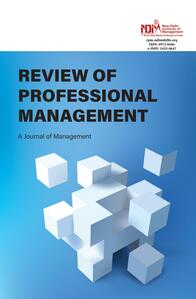
1 School of Business Management, IFTM University, Moradabad, Uttar Pradesh, India
2 Current affiliation: IILM University, Greater Noida, Uttar Pradesh, India

Creative Commons Non Commercial CC BY-NC: This article is distributed under the terms of the Creative Commons Attribution-NonCommercial 4.0 License (http://www.creativecommons.org/licenses/by-nc/4.0/) which permits non-Commercial use, reproduction and distribution of the work without further permission provided the original work is attributed.
As the use of paid posts (PPs) by online influencers (OIs) grows on Facebook, there is limited scientific data on their effectiveness. This study investigates how consumer engagement with PPs compares to that of unpaid posts (UPPs) and how engagement is influenced by whether the posts are shared by major or mini influencers. It also examines the impact of different advertising appeals, distinguishing between informational and transformational appeals. Using binomial regression on a dataset of 55,067 paid Facebook posts, the study finds: (a) Users engage more with PPs than UPPs, (b) mini influencers see a more significant increase in engagement, and (c) major influencers’ informational appeals generate higher engagement than mini influencers’ posts. These findings offer valuable insights for OIs and advertisers in influencer marketing.
Facebook, social media analytics, field data, influencer marketing, online influencers, electric cars
Introduction
Online influencers (OIs) play a crucial role in advertising strategies, attracting significant attention for their ability to drive consumer engagement (Bakker, 2018; More & Lingam, 2019; Zhou et al., 2021). OIs are individuals or organisations who cultivate large followings on digital platforms (Carpenter et al., 2021; Coco & Eckert, 2020; Masuda et al., 2022). Advertisers focus on the engagement levels of OIs’ posts, as higher engagement often leads to increased earnings for the influencers (Gräve & Greff, 2018; Han & Chen, 2022). The key performance metric (KPM) for assessing the success of paid digital media campaigns is engagement (Szczurski, 2017).
Paid posts (PPs) are a form of advertising on social media, where OIs create posts with paid content, often blurring the lines between paid and unpaid material (Glucksman, 2017; Lou et al., 2023). These posts, differing from unpaid posts (UPPs), which lack commercial intent, generate more interaction from consumers, who often engage willingly compared to traditional ads (Abdullah et al., 2020). PPs can use two main advertising appeals: informational and transformational. Informational appeals focus on providing valuable and factual information about a product (Chandawarkar et al., 2018; Jin et al., 2019), while transformational appeals tap into emotions and personal experiences (Andreani et al., 2021; Bakker, 2018). Both types positively impact consumer behaviour and brand perception (Chekima et al., 2020; Nafees et al., 2021).
The effectiveness of these appeals varies with the influencer’s size. Mini influencers, with smaller followings, often create stronger parasocial relationships, encouraging deeper engagement (Bakker, 2018; Cheng et al., 2021), whereas major influencers, with larger followings, leverage credibility and informative content to drive engagement (Abdullah et al., 2020; Zheng et al., 2020). This study, analysing 55,067 Facebook posts, provides insights into how OIs’ follower size and the type of advertising appeal affect user interaction, offering valuable guidance for both marketers and academics in understanding influencer marketing’s efficacy.
The Theoretical Basis
OIs Unpaid Posts
OIs provide marketing value by creating content and building substantial followings (Cheng et al., 2021; Gammoudi et al., 2022). OIs enhance their brand visibility by posting UPPs, which do not promote any specific companies but include personal stories to engage followers. Unlike traditional word-of-mouth (WOM), UPPs are editorial, making this study distinct from WOM research or native advertising (Abdullah et al., 2020; Chekima et al., 2020; Han & Chen, 2022; Kim & Kim, 2021).
Purchased Blog Posts from OIs
Like UPPs, OIs create and publish paid content on social media, but PPs explicitly promote brands and products (Lê Giang Nam, 2018). Sponsored content integrates brands into editorial posts (Gräve, 2019; Harrigan et al., 2021). Unlike UPPs, PPs carry a commercial message, with images and captions playing a crucial role in consumer perception (Hund & McGuigan, 2019; Kim & Kim, 2021; Malik et al., 2023).
PPs that Attract Advertisement
Advertisers use two main types of ad pitches in paid postings: informative and transformational advertising. Informative advertising provides factual, relevant brand information, boosting consumer confidence (Booth & Matic, 2011; Harrigan et al., 2021). It focuses on logical, clear, and practical data (Bakker, 2018; Brooks et al., 2021). Transformational advertising, on the other hand, connects products with emotions and experiences, making the brand feel more engaging and enjoyable (Bakker, 2018; Zhou et al., 2021). While both appeals can coexist, one often dominates the message, with OIs having limited control over the final content (Bakker, 2018; Enke & Borchers, 2021).
An Essential Performance Metric for Influencer Marketing Is Involvement in Internet Media
Consumers’ cognitive and emotional views are expressed through brand-related engagement behaviours on social media, such as likes and comments (Booth & Matic, 2011; Campbell & Farrell, 2020; Gräve, 2019). These interactions serve as key performance indicators (KPIs) in influencer marketing (Brooks et al., 2021; Gupta et al., 2020). Likes and comments reflect consumer involvement, brand trust, and financial success (Abell & Biswas, 2023; Cheng et al., 2021). Advertisers assess engagement based on these actions to evaluate the effectiveness of PPs (Jin et al., 2019; Reinikainen et al., 2021).
Engagement on Social Media and Paid and Unpaid Postings are Connected
A qualitative pre-study was conducted to examine the differences between PPs and UPPs on Facebook. Six OIs, primarily male, with an average age of 30, were interviewed. They noted that PPs demand more time and effort due to financial incentives and brand expectations, with OIs aiming for engaging, authentic content. PPs were seen as offering higher hedonic value, leading to stronger engagement. The study explores how transformational versus informational appeals in PPs influence user interaction compared to UPPs.
To summarise:
H1: Paid postings get higher user engagement than unpaid content.
Mini influencers, with fewer followers, are seen as more authentic and relatable, leading to higher engagement on PPs. In contrast, major influencers may reach wider audiences, but their posts often feel less personal and genuine, resulting in more passive interaction, like views over active engagement, such as likes or comments.
H2: The relationship between online media engagement and the number of followers is less than that of PPs.
We aim to explore how informational versus transformational appeals in PPs affect user engagement. Informational appeals offer clear, actionable brand details, while transformational appeals share personal brand experiences. These differing approaches likely influence how users interact with sponsored content.
H3: More frequently than PPs with transformational appeals, users interact with advertisements with informative appeals.
According to the Elaboration Likelihood Model (ELM), users on platforms like Facebook often process content peripherally, relying on cues like follower count. Major Influencers may gain more attention despite lower engagement, while deeper cognitive processing—linked to higher engagement—occurs when users focus more on the message than surface traits.
H4: Informative appeals in sponsored posts have a greater connection with online media activity than those with transformative appeals.
Method
We used a field data approach to verify our hypotheses, utilising data from an influencer marketing firm specialising in electric passenger vehicles. The dataset included 55,067 Facebook posts from OIs.
Considering Independent Variables
The Endorsement of Facebook Posts Can Be Recognised
To classify Facebook posts as paid or unpaid, we developed an endorsement label system based on three exploratory studies: observational research of 50 full-time OIs (Kim & Kim, 2021), consultations with an influencer marketing agency (Farivar et al., 2022), and a survey of seven OIs (Koay et al., 2023). The endorsement labels used by researchers, companies, and online influencers are summarised in Table 1. PPs typically feature endorsement labels in captions, often with hashtags (Ge & Gretzel, 2018). We used text analysis and manually validated a random sample of 2,400 PP and 2,400 UPPs to ensure accuracy. Endorsement was coded as a binary variable. PPs generally feature either informational or transformational appeals, with one typically dominating the message (Cheng et al., 2021; Koay et al., 2021). Informational appeals, such as discount codes, prompt immediate consumer action (Harrigan et al., 2021).
Table 1. Endorsement Labels: Three Perspectives on Labelling Paid Posts.

The frequency of informative and transformational appeals in advertising messages may vary, even if they are not mutually exclusive (Hudders & De Jans, 2022; Jin et al., 2019; Weismueller et al., 2020). However, one frequently predominates in a marketing message even when both sorts of solicitations are permissible (Farivar et al., 2022; Harrigan et al., 2021; Reinikainen et al., 2021; Szczurski, 2017). Advertising that primarily focuses on businesses and their products tends to favour informational appeals (Coates et al., 2019; Masuda et al., 2022). On the other hand, transformative appeals take centre stage when advertising emphasises the experience associated with companies and products (Booth & Matic, 2011; Hudders & De Jans, 2022; Koay et al., 2023; Lou, 2022). A marketing message, as a result, narrows its attention to only one appeal. This viewpoint is consistent with earlier research that divides appeals into informational and transformative forms using a binary categorisation (Bakker, 2018; Farivar et al., 2022; Lou & Yuan, 2019; Szczurski, 2017). As a result, we classify the attractiveness of advertising as dichotomous.
In line with best practices, advertising appeals are categorised dichotomously as either informational or transformational. Informational appeals are prioritised in PPs, with other appeals disregarded. Word detection was used to identify keywords for each appeal type, and manual tests validated consistency. Keywords commonly associated with informational appeals are listed in Table 2, and an example of a sponsored post containing a discount code is illustrated in Figure 1. We found that PPs with informational appeals averaged 359 characters, while those with transformational appeals averaged 412 characters (Freberg et al., 2011; Lee & Theokary, 2021; Valsesia et al., 2020). The differentiation between appeals relies on the length and focus of the captions.
Figure 1. A Sample Caption for a Sponsored Post Containing a Discount Code.

Source: Facebook (2022).
Model Specification
The model is described as follows:
Table 2. Appealing to Information in Paid Posts and Keywords.


i stands for the specific post that was posted to a Facebook profile (i = 1, 2, 64,438).
The dependent variable (DV) is overall engagement (POST_ENGAGEMENT), measured by the sum of comments and likes. The endorsement variable (Paid posted) is a dummy variable, set to 1 for PPs. The appeal variable (Information) distinguishes between informational and transformational appeals. A continuous variable (Followers) represents the number of followers of the influencer (OI). To control for confounding factors, we include variables for post timing: a weekend dummy (weekend) and a working hour dummy (PostingTime). Additionally, post characteristics such as text length (TextContent), exclamations (Exclamations), emojis (Emojis), mentions (Mentions), hashtags (Hashtags), and content type (ContentQuality) are incorporated to account for different engagement levels. Dynamic content, like videos, is set to 1, while static content is set to 0, as it may generate stronger engagement.
Statistical Technique
Our DV, engagement, showed overdispersion (M = 1, VAR = 9,442,609). To address this, we conducted an overdispersion test using a Poisson model (Cameron & Trivedi, 1990), which confirmed overdispersion (p < .001). We applied negative binomial regression, as recommended by Greene (2007), to account for this. Our analysis included two phases: first, comparing PP and UPPs with 55,067 posts, and second, focusing on 4,821 PPs to assess the effect of advertising appeal on engagement. Heteroskedasticity was confirmed via the Breusch-Pagan test (p < .001), and we adjusted standard errors accordingly. Results are presented in Table 5. The results of the negative binomial regression model are presented in Table 4.
Table 3. Shows the Correlations Between Every Variable that was Gathered for our Empirical Investigations.

Table 4. Negative Binomial Regression Findings.
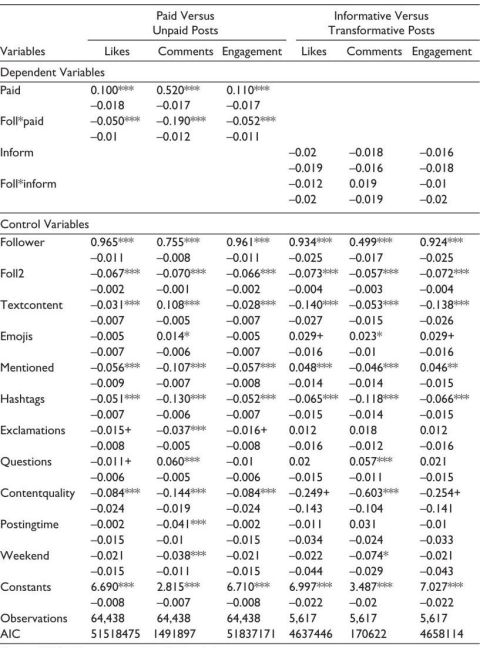
Notes: 9,800 followers were identified as followers.
We presented robust standard errors and standardised coefficients.
+p < .1; *p < .05; **p < .01; ***p < .001.
Table 5. Data Estimation Utilised Negative Binomial Regression.
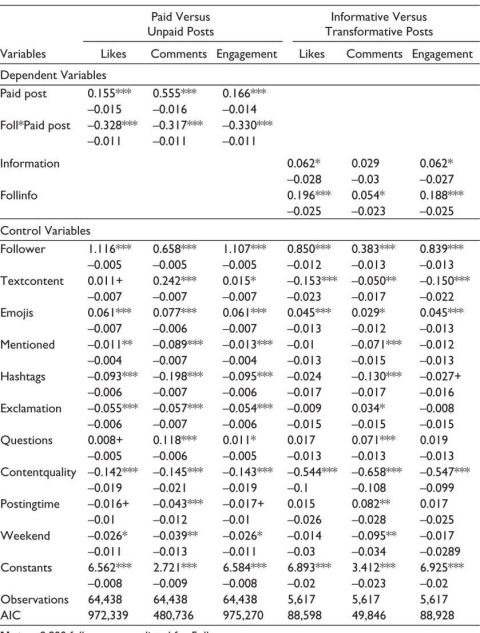
Notes: 9,800 followers were listed for Follower.
We presented robust standard errors and standardised coefficients.
+p < .1; *p < .05; **p < .01; ***p < .001.
Statement of the Result
Below is the revised wording, with the values changed to match the table:
The dataset consisted of 55,067 Facebook posts from 2018 to 2022, including both UPPs and PPs. Most posts (99%) were from this period, with 24% posted on weekends and 43% during work hours. Emojis appeared in 72% of captions, and 69% included hashtags. The relationships among all variables used in this empirical analysis are presented in Table 3. On average, posts had 254 characters, with 8.37% containing dynamic content. Posts received between 0 and 111,386 likes and 0–150 comments, averaging 1,173.58 likes and 7 comments. PPs averaged 1,559.21 engagements, while UPPs averaged 1,157.38. Informational appeals had 1,481.38 engagements, and transformative appeals had 1,609.18.
Estimation Results
Our data supports the first hypothesis, showing that sponsored posts generate more engagement than unpaid ones (= 0.166***, p = .001). Sponsored posts received significantly more likes (= 0.155***) and comments (= 0.555***). The second hypothesis is also confirmed, with a negative interaction between followers and engagement on PPs (= –0.330***, p = .001). The third hypothesis, concerning informational appeals, showed a significant positive relationship with likes (= 0.062*, p = .05) but no significant effect on comments. The fourth hypothesis is supported, revealing a positive correlation between followers and engagement on informational posts (= 0.188***, p = .001). To further validate these findings, a linear regression was conducted; the results are shown in Table 6.
Table 6. Results of the Estimation: Linear Regression.
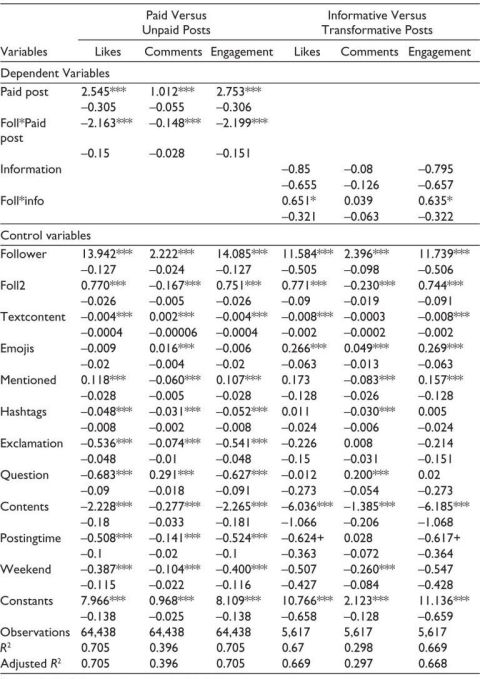
Notes: 9,800 followers were reported as followers.
We used a square root modification in order to lessen the skewness of the number of followers.
We presented robust standard errors and standardised coefficients.
+p < .1; *p < .05; **p < .01; ***p < .001.
Finally, we considered a variety of control parameters. We included a number of post characteristics (Textcontent, Emojis, Mentioned, Hashtags, Exclamation, Question) in the models to take potential post qualities into consideration. Subsample-based estimations are reported in Table 7, confirming the robustness of our results. We also considered the effects of time (Postingtime, Weekend), as well as post-related factors (Contents). No extra interpretation was required because the control variables were primarily created to capture and control for a number of post-specific characteristics that may impact our DVs.
Table 7. Estimation Outcomes: Subsample-based Negative Binomial Regression.
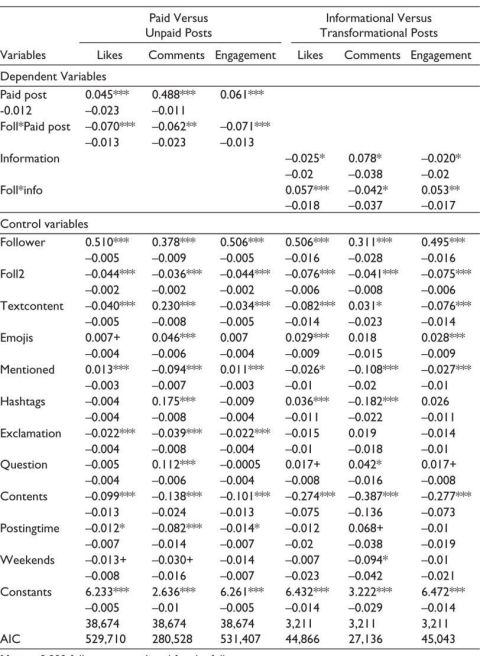
Notes: 9,800 followers were listed for the follower.
We presented robust standard errors and standardised coefficients.
+p < .1; *p < .05; **p < .01; ***p < .001.
Testing
We performed multiple robustness checks to ensure the accuracy of our findings. These included adding a quadratic term for followers (Foll2) and using a square root transformation of the DV. We also excluded extreme engagement posts and conducted a negative binomial regression on a subsample, confirming our hypotheses. Lastly, we adjusted the DV by converting comments to likes, with consistent results across all tests, further supporting our model. Alternative model specifications using different dependent variables are summarised in Table 8.
Table 8. Estimation Findings: Alternative Dependent Variables in Negative Binomial Regression.
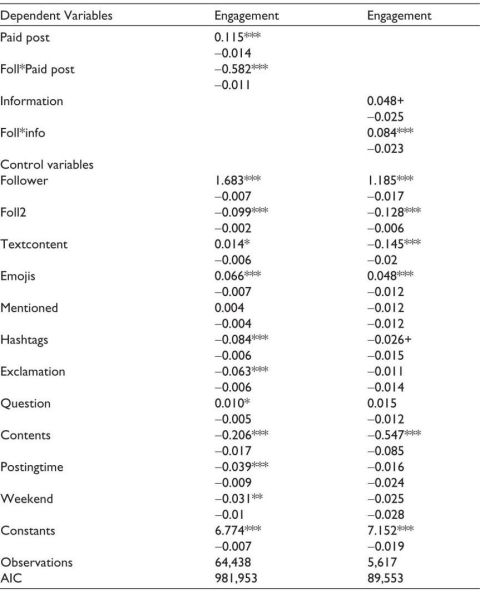
Notes: 9,800 followers were listed for the follower.
We presented robust standard errors and standardised coefficients.
+p < .1; *p < .05; **p < .01; ***p < .001.
Discussion
This study examines how Facebook-sponsored posts impact online engagement, focusing on influencer marketing, follower count, and advertising appeals. Results show PPs generate more engagement than unpaid ones, aligning with hedonic value (Brooks et al., 2021; Glucksman, 2017). A negative relationship between follower size and engagement is found, especially for macro-influencers (Freberg et al., 2011). Influencer type, not appeal type, drives engagement, supporting the ELM (Petty & Cacioppo, 1986).
Theoretical Repercussions
This study explores how both the substance of messages and OIs’ characteristics impact social media engagement with PPs. We find that PPs are more engaging when shared by macro-influencers, especially when they feature educational appeals. This aligns with information processing theory and the ELM (Campbell & Farrell, 2020; Lou et al., 2023). Our research extends existing studies by incorporating both content qualities and OI attributes, suggesting that engagement increases with larger followings and educational appeals (Harrigan et al., 2021; Kim & Kim, 2021). Future research can further investigate these dynamics.
Influencers on the Web (OIs)
Regardless of their followers’ cooperation, OIs should focus on sharing their expertise and building their followers’ trust. This may be achieved by developing UPPs that have similar hedonic value and help them build stronger relationships with their followers.
Limitations and Suggestions for Additional Research
Future research could explore additional KPIs like sentiment analysis, engagement with unpaid PPs, blending informational and transformational appeals, influencer gender effects, hedonic value, information processing, and using comprehensive data sources. A limitation of this study is its reliance on Facebook data, which may not fully represent other platforms.
Conclusion
This study enhances the understanding of influencer marketing by analysing online media engagement with paid Facebook posts, focusing on actual user behaviour. It offers recommendations for future research on product categories, OI-brand fit, and further exploration of factors influencing engagement with paid content, providing a foundation for deeper insights.
Declaration of Conflicting Interests
The authors declared no potential conflicts of interest with respect to the research, authorship and/or publication of this article.
Funding
The authors received no financial support for the research, authorship and/or publication of this article.
ORCID iD
Pankaj Sharma  https://orcid.org/0000-0001-5679-7483
https://orcid.org/0000-0001-5679-7483
Abdullah, T., Deraman, S. N. S., Zainuddin, S. A., Azmi, N. F., Abdullah, S. S., Anuar, N. I. M., Mohamad, S. R., Hashim, N., Amri, N. A., & Abdullah, A.-R. (2020). Impact of social media influencer on Instagram user purchase intention towards the fashion products: The perspectives of UMK Pengkalan Chepa Campus students. European Journal of Molecular & Clinical Medicine, 7(1), 2589–2598.
Abell, A., & Biswas, D. (2023). Digital engagement on social media: How food image content influences social media and influencer marketing outcomes. Journal of Interactive Marketing, 58(1), 1–15.
Andreani, F., Gunawan, L., & Haryono, S. (2021). Social media influencer, brand awareness, and purchase decision among Generation Z in Surabaya. Jurnal Manajemen Dan Kewirausahaan, 23(1), 18–26.
Bakker, D. (2018). Conceptualising influencer marketing. Journal of Emerging Trends in Marketing and Management, 1(1), 79–87.
Booth, N., & Matic, J. A. (2011). Mapping and leveraging influencers in social media to shape corporate brand perceptions. Corporate Communications: An International Journal, 16(3), 184–191.
Brooks, G., Drenten, J., & Piskorski, M. J. (2021). Influencer celebrification: How social media influencers acquire celebrity capital. Journal of Advertising, 50(5), 528–547.
Cameron, A. C., & Trivedi, P. K. (1990). Regression-based tests for overdispersion in the Poisson model. Journal of Econometrics, 46(3), 347–364.
Campbell, C., & Farrell, J. R. (2020). More than meets the eye: The functional components underlying influencer marketing. Business Horizons, 63(4), 469–479.
Carpenter, J. P., Shelton, C. C., Curcio, R., & Schroeder, S. (2021). The education influencer: New possibilities and challenges for teachers in the social media world. In D. Becker & R. H. Chen (Eds.), Proceedings of society for information technology & teacher education international conference (SITE 2021) (pp. 1712–1721). Association for the Advancement of Computing in Education (AACE). https://www.learntechlib.org/primary/p/219407/
Chandawarkar, A. A., Gould, D. J., & Grant Stevens, W. (2018). The top 100 social media influencers in plastic surgery on Twitter: Who should you be following? Aesthetic Surgery Journal, 38(8), 913–917.
Chekima, B., Chekima, F. Z., & Adis, A.-A. A. (2020). Social media influencer in advertising: The role of attractiveness, expertise and trustworthiness. Journal of Economics and Business, 3(4), 1582–1592.
Cheng, Y., Hung-Baesecke, C.-J. F., & Chen, Y.-R. R. (2021). Social media influencer effects on CSR communication: The role of influencer leadership in opinion and taste. International Journal of Business Communication. https://doi.org/10.1177/232 94884211035112
Coates, A. E., Hardman, C. A., Halford, J. C., Christiansen, P., & Boyland, E. J. (2019). Social media influencer marketing and children’s food intake: A randomized trial. Pediatrics, 143(4), e20182554.
Coco, S. L., & Eckert, S. (2020). #Sponsored: Consumer insights on social media influencer marketing. Public Relations Inquiry, 9(2), 177–194.
Enke, N., & Borchers, N. S. (2021). Social media influencers in strategic communication: A conceptual framework for strategic social media influencer communication. In Social media influencers in strategic communication (pp. 7–23). Routledge.
Farivar, S., Wang, F., & Turel, O. (2022). Followers’ problematic engagement with influencers on social media: An attachment theory perspective. Computers in Human Behavior, 133, 107288.
Freberg, K., Graham, K., McGaughey, K., & Freberg, L. A. (2011). Who are the social media influencers? A study of public perceptions of personality. Public Relations Review, 37(1), 90–92.
Gammoudi, F., Sendi, M., & Omri, M. N. (2022). A survey on social media influence environment and influencers identification. Social Network Analysis and Mining, 12(1), 145.
Ge, J., & Gretzel, U. (2018). Emoji rhetoric: A social media influencer perspective. Journal of Marketing Management, 34(15–16), 1272–1295.
Glucksman, M. (2017). The rise of social media influencer marketing on lifestyle branding: A case study of Lucie Fink. Elon Journal of Undergraduate Research in Communications, 8(2), 77–87.
Gräve, J.-F. (2019). What KPIs are key? Evaluating performance metrics for social media influencers. Social Media + Society, 5(3), 2056305119865475.
Gräve, J.-F., & Greff, A. (2018). Good KPI, good influencer? Evaluating success metrics for social media influencers. In Proceedings of the 9th international conference on social media and society (SMSociety ’18, July 18–20, 2018, Copenhagen, Denmark) (pp. 291–295). Association for Computing Machinery (ACM). https://doi.org/10.1145/3217804.3217932
Greene, W. H. (2007). Functional forms for the negative binomial model for count data. Economics Letters, 99(3), 585–590.
Gupta, N., Dorfman, R., Saadat, S., & Roostaeian, J. (2020). The plastic surgery social media influencer: Ethical considerations and a literature review. Aesthetic Surgery Journal, 40(6), 691–699.
Han, J., & Chen, H. (2022). Millennial social media users’ intention to travel: The moderating role of social media influencer following behavior. International Hospitality Review, 36(2), 340–357.
Harrigan, P., Daly, T. M., Coussement, K., Lee, J. A., Soutar, G. N., & Evers, U. (2021). Identifying influencers on social media. International Journal of Information Management, 56, 102246.
Hudders, L., & De Jans, S. (2022). Gender effects in influencer marketing: An experimental study on the efficacy of endorsements by same- vs. other-gender social media influencers on Instagram. International Journal of Advertising, 41(1), 128–149.
Hund, E., & McGuigan, L. (2019). A shoppable life: Performance, selfhood, and influence in the social media storefront. Communication, Culture & Critique, 12(1), 18–35.
Jin, S. V., Muqaddam, A., & Ryu, E. (2019). Instafamous and social media influencer marketing. Marketing Intelligence & Planning, 37(5), 567–579.
Kim, D. Y., & Kim, H.-Y. (2021). Influencer advertising on social media: The multiple inference model on influencer-product congruence and sponsorship disclosure. Journal of Business Research, 130, 405–415.
Koay, K. Y., Teoh, C. W., & Soh, P. C. (2021). Instagram influencer marketing: Perceived social media marketing activities and online impulse buying. First Monday, 26(9), 1–20. https://doi.org/10.5210/fm.v26i9.11691
Koay, K. Y., Tjiptono, F., Teoh, C. W., Memon, M. A., & Connolly, R. (2023). Social media influencer marketing: Commentary on the special issue. Journal of Internet Commerce, 22(sup1), S1–S3.
Lê Giang Nam, H. T. D. (2018). Impact of social media influencer marketing on consumer at Ho Chi Minh City. The International Journal of Social Sciences and Humanities Invention, 5(05), 4710–4714.
Lee, M. T., & Theokary, C. (2021). The superstar social media influencer: Exploiting linguistic style and emotional contagion over content? Journal of Business Research, 132, 860–871.
Lou, C. (2022). Social media influencers and followers: Theorization of a trans-parasocial relation and explication of its implications for influencer advertising. Journal of Advertising, 51(1), 4–21.
Lou, C., Taylor, C. R., & Zhou, X. (2023). Influencer marketing on social media: How different social media platforms afford influencer–follower relation and drive advertising effectiveness. Journal of Current Issues & Research in Advertising, 44(1), 60–87.
Lou, C., & Yuan, S. (2019). Influencer marketing: How message value and credibility affect consumer trust of branded content on social media. Journal of Interactive Advertising, 19(1), 58–73.
Malik, A. Z., Thapa, S., & Paswan, A. K. (2023). Social media influencer (SMI) as a human brand: A need fulfillment perspective. Journal of Product & Brand Management, 32(2), 173–190.
Masuda, H., Han, S. H., & Lee, J. (2022). Impacts of influencer attributes on purchase intentions in social media influencer marketing: Mediating roles of characterizations. Technological Forecasting and Social Change, 174, 121246.
More, J. S., & Lingam, C. (2019). A SI model for social media influencer maximization. Applied Computing and Informatics, 15(2), 102–108.
Nafees, L., Cook, C. M., Nikolov, A. N., & Stoddard, J. E. (2021). Can social media influencer (SMI) power influence consumer brand attitudes? The mediating role of perceived SMI credibility. Digital Business, 1(2), 100008.
Petty, R. E., & Cacioppo, J. T. (1986). Communication and persuasion: Central and peripheral routes to attitude change. Springer-Verlag.
Reinikainen, H., Tan, T. M., Luoma-Aho, V., & Salo, J. (2021). Making and breaking relationships on social media: The impacts of brand and influencer betrayals. Technological Forecasting and Social Change, 171, 120990.
Szczurski, M. (2017). Social media influencer: A lifestyle or a profession of the 21st century? Open ICM. https://open.icm.edu.pl/items/a374cea5-3ca6-493a-8a00-691c9961f2a5
Valsesia, F., Proserpio, D., & Nunes, J. C. (2020). The positive effect of not following others on social media. Journal of Marketing Research, 57(6), 1152–1168.
Weismueller, J., Harrigan, P., Wang, S., & Soutar, G. N. (2020). Influencer endorsements: How advertising disclosure and source credibility affect consumer purchase intention on social media. Australasian Marketing Journal, 28(4), 160–170.
Zheng, C., Zhang, Q., Young, S., & Wang, W. (2020). On-demand influencer discovery on social media. In Proceedings of the 29th ACM international conference on information & knowledge management (CIKM ’20) (pp. 2337–2340). Association for Computing Machinery (ACM). https://doi.org/10.1145/3340531.3412057
Zhou, S., Blazquez, M., McCormick, H., & Barnes, L. (2021). How social media influencers’ narrative strategies benefit cultivating influencer marketing: Tackling issues of cultural barriers, commercialised content, and sponsorship disclosure. Journal of Business Research, 134, 122–142